MNG82210 Team Effectiveness: Report on Team Dynamics & Project
VerifiedAdded on 2023/06/10
|10
|2220
|124
Report
AI Summary
This report examines team effectiveness within an organizational context, focusing on a four-person team undertaking a construction project for a shopping mall. It utilizes the Team Effectiveness Model to analyze key features of the team, justifies the team approach versus individual work, and assesses the team's ability to adapt to a dynamic external environment. The report emphasizes the importance of trust, communication, and collective skills within the team, highlighting how these elements contribute to achieving common goals and enhancing individual development. Furthermore, it addresses the challenges posed by external factors such as political, technological, socio-cultural, and legal variables, and underscores the necessity for teams to strategically respond to changes to maintain effectiveness.
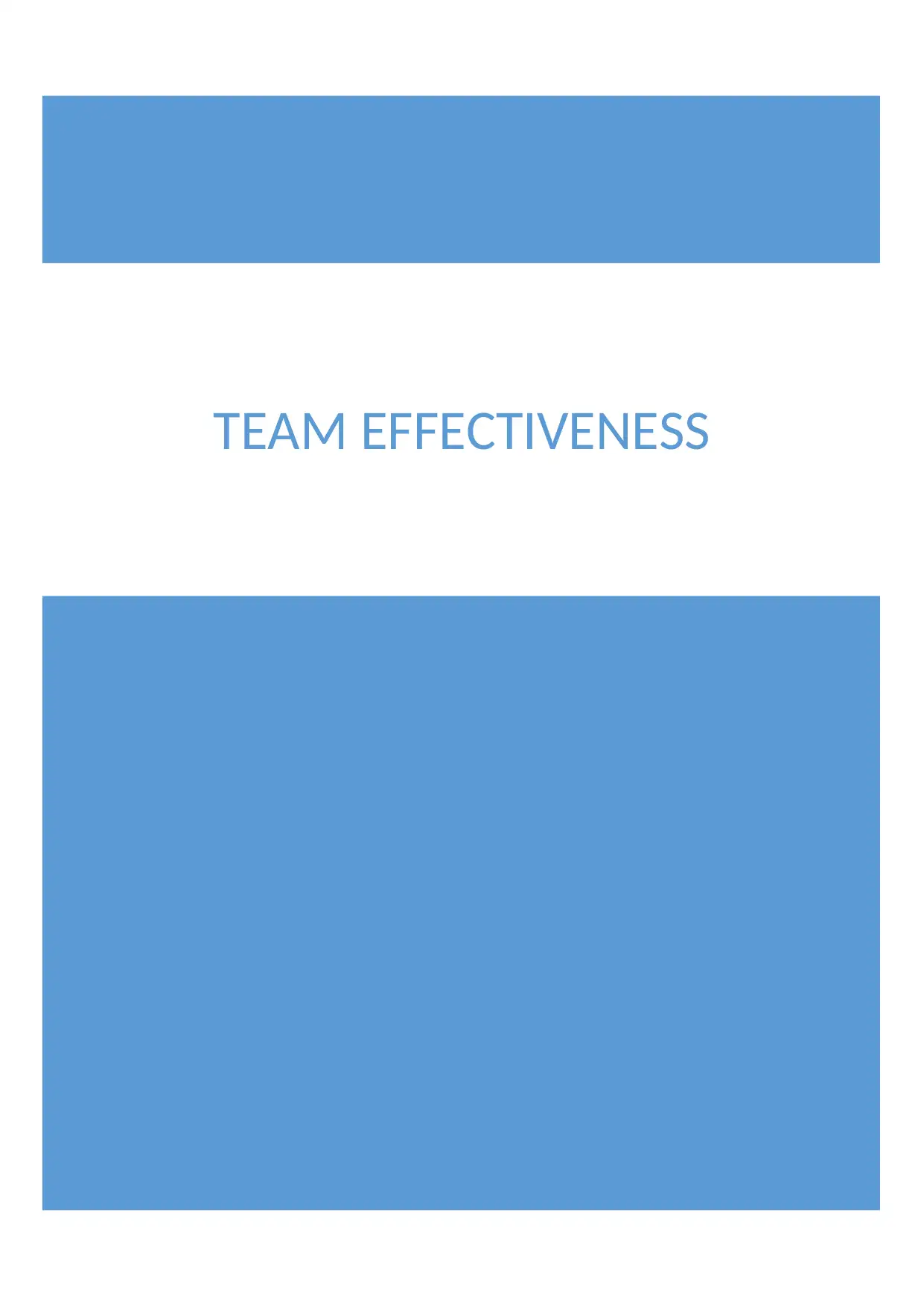
TEAM EFFECTIVENESS
Paraphrase This Document
Need a fresh take? Get an instant paraphrase of this document with our AI Paraphraser
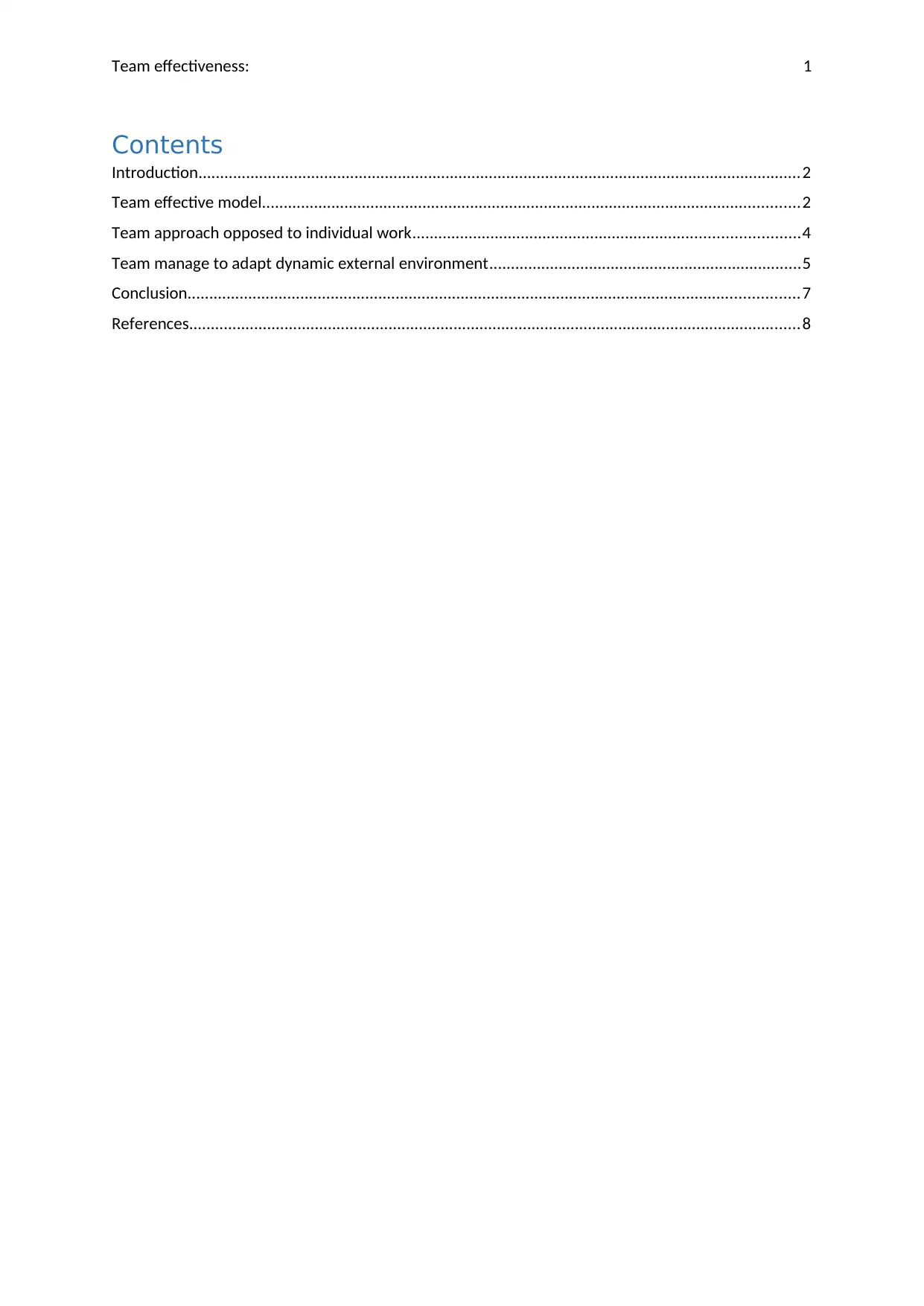
Team effectiveness: 1
Contents
Introduction...........................................................................................................................................2
Team effective model............................................................................................................................2
Team approach opposed to individual work.........................................................................................4
Team manage to adapt dynamic external environment........................................................................5
Conclusion.............................................................................................................................................7
References.............................................................................................................................................8
Contents
Introduction...........................................................................................................................................2
Team effective model............................................................................................................................2
Team approach opposed to individual work.........................................................................................4
Team manage to adapt dynamic external environment........................................................................5
Conclusion.............................................................................................................................................7
References.............................................................................................................................................8
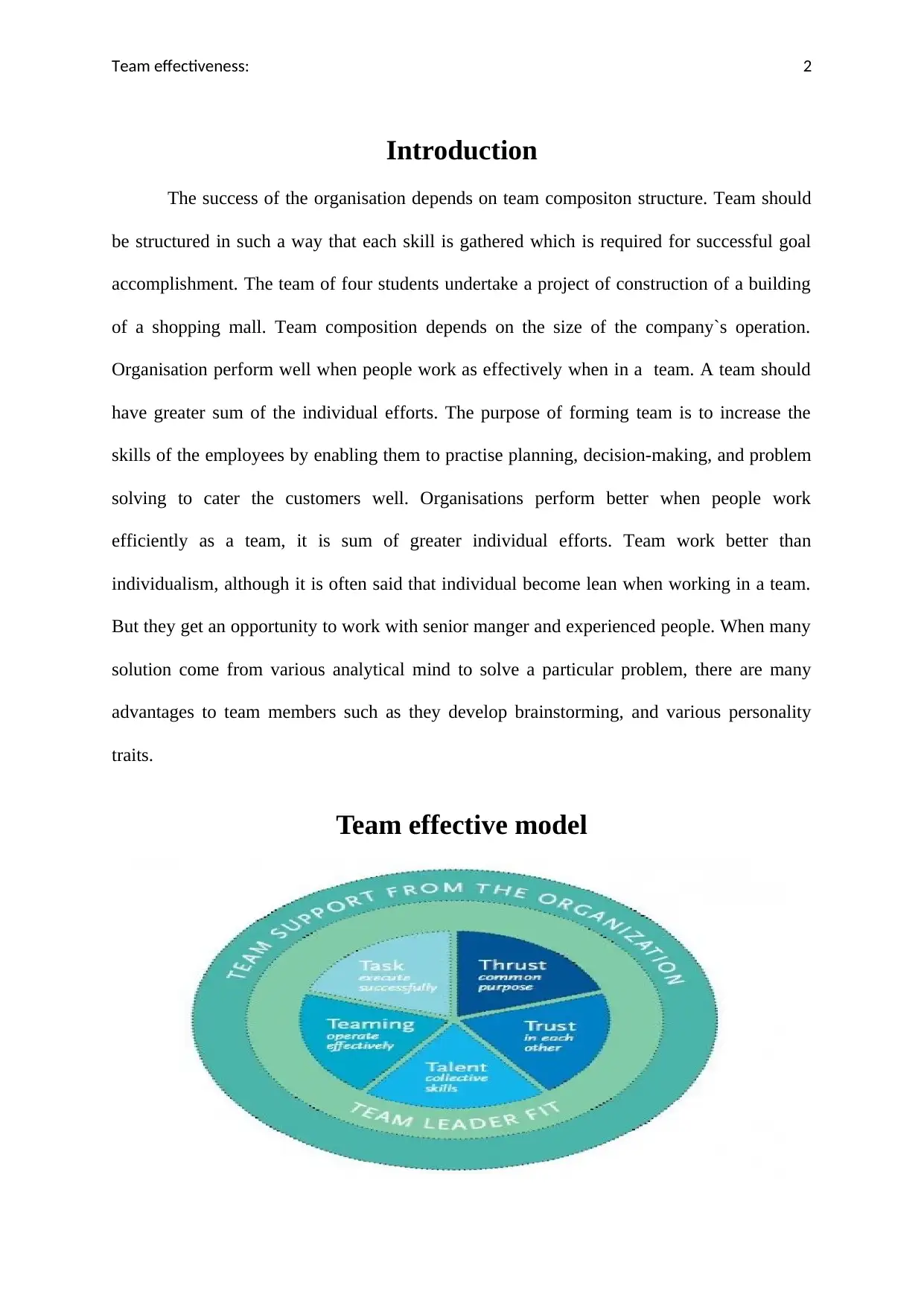
Team effectiveness: 2
Introduction
The success of the organisation depends on team compositon structure. Team should
be structured in such a way that each skill is gathered which is required for successful goal
accomplishment. The team of four students undertake a project of construction of a building
of a shopping mall. Team composition depends on the size of the company`s operation.
Organisation perform well when people work as effectively when in a team. A team should
have greater sum of the individual efforts. The purpose of forming team is to increase the
skills of the employees by enabling them to practise planning, decision-making, and problem
solving to cater the customers well. Organisations perform better when people work
efficiently as a team, it is sum of greater individual efforts. Team work better than
individualism, although it is often said that individual become lean when working in a team.
But they get an opportunity to work with senior manger and experienced people. When many
solution come from various analytical mind to solve a particular problem, there are many
advantages to team members such as they develop brainstorming, and various personality
traits.
Team effective model
Introduction
The success of the organisation depends on team compositon structure. Team should
be structured in such a way that each skill is gathered which is required for successful goal
accomplishment. The team of four students undertake a project of construction of a building
of a shopping mall. Team composition depends on the size of the company`s operation.
Organisation perform well when people work as effectively when in a team. A team should
have greater sum of the individual efforts. The purpose of forming team is to increase the
skills of the employees by enabling them to practise planning, decision-making, and problem
solving to cater the customers well. Organisations perform better when people work
efficiently as a team, it is sum of greater individual efforts. Team work better than
individualism, although it is often said that individual become lean when working in a team.
But they get an opportunity to work with senior manger and experienced people. When many
solution come from various analytical mind to solve a particular problem, there are many
advantages to team members such as they develop brainstorming, and various personality
traits.
Team effective model
⊘ This is a preview!⊘
Do you want full access?
Subscribe today to unlock all pages.

Trusted by 1+ million students worldwide

Team effectiveness: 3
(Source: Valdellon, 2016)
Team effectiveness model
Successful Task execution- Before executing any task, the organisation manages the
team task through delegating responsibility to every member of a team. It involves making
plans, organising & reporting every aspect of the construction. Task is allocated to person
according to their status, qualification, & capacity. Mangers and leaders suffer from growing
complex external environment. Therefore, leaders try to attract and find relevant talent to
whom leaders can delegate their responsibilities and tasks (Shuffler, Diazgranados, Maynard,
& Salas, 2018).
Trust in each other- Communication and trust is the key to make team.
Communication is essential part of team environment (Leoisaac, 2018). It is expected that
each fellow member is aware of its responsibility to conduct a task in a successful manner.
Lack of communication wastes time, efforts, & resources. Open communication plays an
important role in building trust among team members. Trust among each other can create an
environment, which increases morale, productivity and indirectly adds quality in members
work (Levi, 2015).
Talent collective skills- Various successful organisations build team and exploit the
teamwork. In effective team, each member is aware of its roles, which add value to task. Each
member does not have same potential. If one member is efficient in managing task, other may
have the quality of analysing task. Combining all the skills of members create skilled team
where task is delegated according to the efficiency of the member. Through identifying
creative talent skills, manager strives to find root cause of business problem. Ultimately,
(Source: Valdellon, 2016)
Team effectiveness model
Successful Task execution- Before executing any task, the organisation manages the
team task through delegating responsibility to every member of a team. It involves making
plans, organising & reporting every aspect of the construction. Task is allocated to person
according to their status, qualification, & capacity. Mangers and leaders suffer from growing
complex external environment. Therefore, leaders try to attract and find relevant talent to
whom leaders can delegate their responsibilities and tasks (Shuffler, Diazgranados, Maynard,
& Salas, 2018).
Trust in each other- Communication and trust is the key to make team.
Communication is essential part of team environment (Leoisaac, 2018). It is expected that
each fellow member is aware of its responsibility to conduct a task in a successful manner.
Lack of communication wastes time, efforts, & resources. Open communication plays an
important role in building trust among team members. Trust among each other can create an
environment, which increases morale, productivity and indirectly adds quality in members
work (Levi, 2015).
Talent collective skills- Various successful organisations build team and exploit the
teamwork. In effective team, each member is aware of its roles, which add value to task. Each
member does not have same potential. If one member is efficient in managing task, other may
have the quality of analysing task. Combining all the skills of members create skilled team
where task is delegated according to the efficiency of the member. Through identifying
creative talent skills, manager strives to find root cause of business problem. Ultimately,
Paraphrase This Document
Need a fresh take? Get an instant paraphrase of this document with our AI Paraphraser
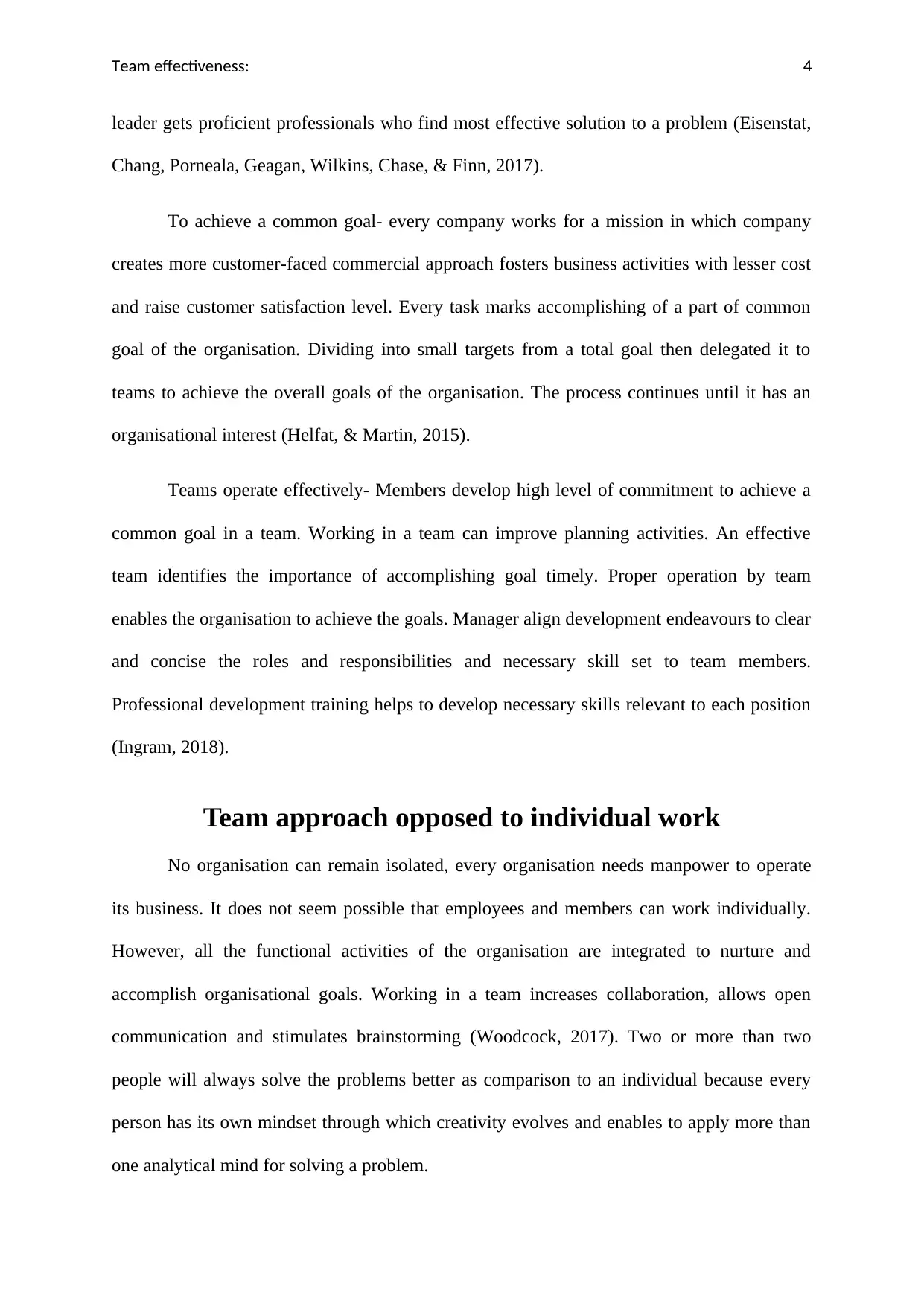
Team effectiveness: 4
leader gets proficient professionals who find most effective solution to a problem (Eisenstat,
Chang, Porneala, Geagan, Wilkins, Chase, & Finn, 2017).
To achieve a common goal- every company works for a mission in which company
creates more customer-faced commercial approach fosters business activities with lesser cost
and raise customer satisfaction level. Every task marks accomplishing of a part of common
goal of the organisation. Dividing into small targets from a total goal then delegated it to
teams to achieve the overall goals of the organisation. The process continues until it has an
organisational interest (Helfat, & Martin, 2015).
Teams operate effectively- Members develop high level of commitment to achieve a
common goal in a team. Working in a team can improve planning activities. An effective
team identifies the importance of accomplishing goal timely. Proper operation by team
enables the organisation to achieve the goals. Manager align development endeavours to clear
and concise the roles and responsibilities and necessary skill set to team members.
Professional development training helps to develop necessary skills relevant to each position
(Ingram, 2018).
Team approach opposed to individual work
No organisation can remain isolated, every organisation needs manpower to operate
its business. It does not seem possible that employees and members can work individually.
However, all the functional activities of the organisation are integrated to nurture and
accomplish organisational goals. Working in a team increases collaboration, allows open
communication and stimulates brainstorming (Woodcock, 2017). Two or more than two
people will always solve the problems better as comparison to an individual because every
person has its own mindset through which creativity evolves and enables to apply more than
one analytical mind for solving a problem.
leader gets proficient professionals who find most effective solution to a problem (Eisenstat,
Chang, Porneala, Geagan, Wilkins, Chase, & Finn, 2017).
To achieve a common goal- every company works for a mission in which company
creates more customer-faced commercial approach fosters business activities with lesser cost
and raise customer satisfaction level. Every task marks accomplishing of a part of common
goal of the organisation. Dividing into small targets from a total goal then delegated it to
teams to achieve the overall goals of the organisation. The process continues until it has an
organisational interest (Helfat, & Martin, 2015).
Teams operate effectively- Members develop high level of commitment to achieve a
common goal in a team. Working in a team can improve planning activities. An effective
team identifies the importance of accomplishing goal timely. Proper operation by team
enables the organisation to achieve the goals. Manager align development endeavours to clear
and concise the roles and responsibilities and necessary skill set to team members.
Professional development training helps to develop necessary skills relevant to each position
(Ingram, 2018).
Team approach opposed to individual work
No organisation can remain isolated, every organisation needs manpower to operate
its business. It does not seem possible that employees and members can work individually.
However, all the functional activities of the organisation are integrated to nurture and
accomplish organisational goals. Working in a team increases collaboration, allows open
communication and stimulates brainstorming (Woodcock, 2017). Two or more than two
people will always solve the problems better as comparison to an individual because every
person has its own mindset through which creativity evolves and enables to apply more than
one analytical mind for solving a problem.
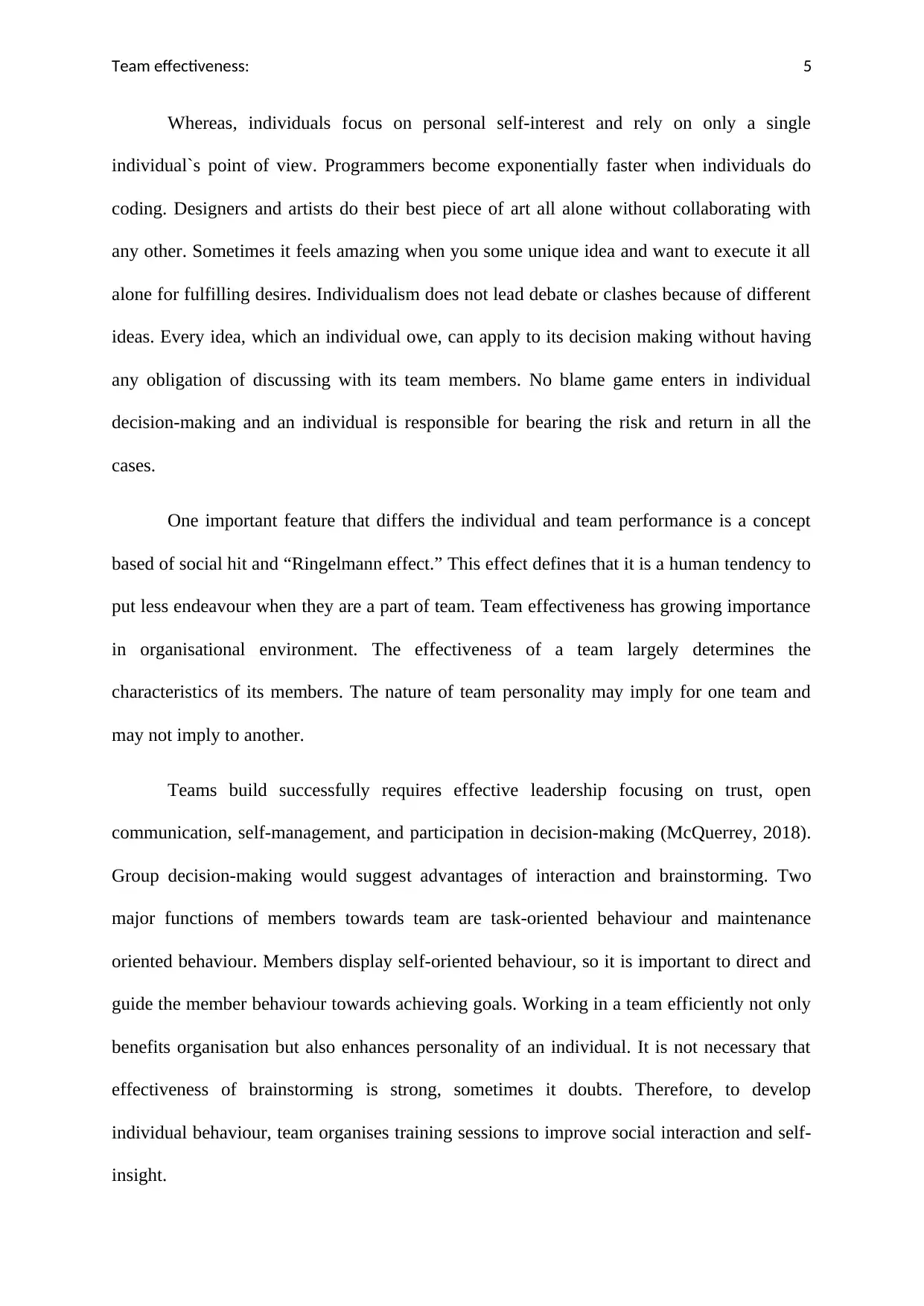
Team effectiveness: 5
Whereas, individuals focus on personal self-interest and rely on only a single
individual`s point of view. Programmers become exponentially faster when individuals do
coding. Designers and artists do their best piece of art all alone without collaborating with
any other. Sometimes it feels amazing when you some unique idea and want to execute it all
alone for fulfilling desires. Individualism does not lead debate or clashes because of different
ideas. Every idea, which an individual owe, can apply to its decision making without having
any obligation of discussing with its team members. No blame game enters in individual
decision-making and an individual is responsible for bearing the risk and return in all the
cases.
One important feature that differs the individual and team performance is a concept
based of social hit and “Ringelmann effect.” This effect defines that it is a human tendency to
put less endeavour when they are a part of team. Team effectiveness has growing importance
in organisational environment. The effectiveness of a team largely determines the
characteristics of its members. The nature of team personality may imply for one team and
may not imply to another.
Teams build successfully requires effective leadership focusing on trust, open
communication, self-management, and participation in decision-making (McQuerrey, 2018).
Group decision-making would suggest advantages of interaction and brainstorming. Two
major functions of members towards team are task-oriented behaviour and maintenance
oriented behaviour. Members display self-oriented behaviour, so it is important to direct and
guide the member behaviour towards achieving goals. Working in a team efficiently not only
benefits organisation but also enhances personality of an individual. It is not necessary that
effectiveness of brainstorming is strong, sometimes it doubts. Therefore, to develop
individual behaviour, team organises training sessions to improve social interaction and self-
insight.
Whereas, individuals focus on personal self-interest and rely on only a single
individual`s point of view. Programmers become exponentially faster when individuals do
coding. Designers and artists do their best piece of art all alone without collaborating with
any other. Sometimes it feels amazing when you some unique idea and want to execute it all
alone for fulfilling desires. Individualism does not lead debate or clashes because of different
ideas. Every idea, which an individual owe, can apply to its decision making without having
any obligation of discussing with its team members. No blame game enters in individual
decision-making and an individual is responsible for bearing the risk and return in all the
cases.
One important feature that differs the individual and team performance is a concept
based of social hit and “Ringelmann effect.” This effect defines that it is a human tendency to
put less endeavour when they are a part of team. Team effectiveness has growing importance
in organisational environment. The effectiveness of a team largely determines the
characteristics of its members. The nature of team personality may imply for one team and
may not imply to another.
Teams build successfully requires effective leadership focusing on trust, open
communication, self-management, and participation in decision-making (McQuerrey, 2018).
Group decision-making would suggest advantages of interaction and brainstorming. Two
major functions of members towards team are task-oriented behaviour and maintenance
oriented behaviour. Members display self-oriented behaviour, so it is important to direct and
guide the member behaviour towards achieving goals. Working in a team efficiently not only
benefits organisation but also enhances personality of an individual. It is not necessary that
effectiveness of brainstorming is strong, sometimes it doubts. Therefore, to develop
individual behaviour, team organises training sessions to improve social interaction and self-
insight.
⊘ This is a preview!⊘
Do you want full access?
Subscribe today to unlock all pages.

Trusted by 1+ million students worldwide
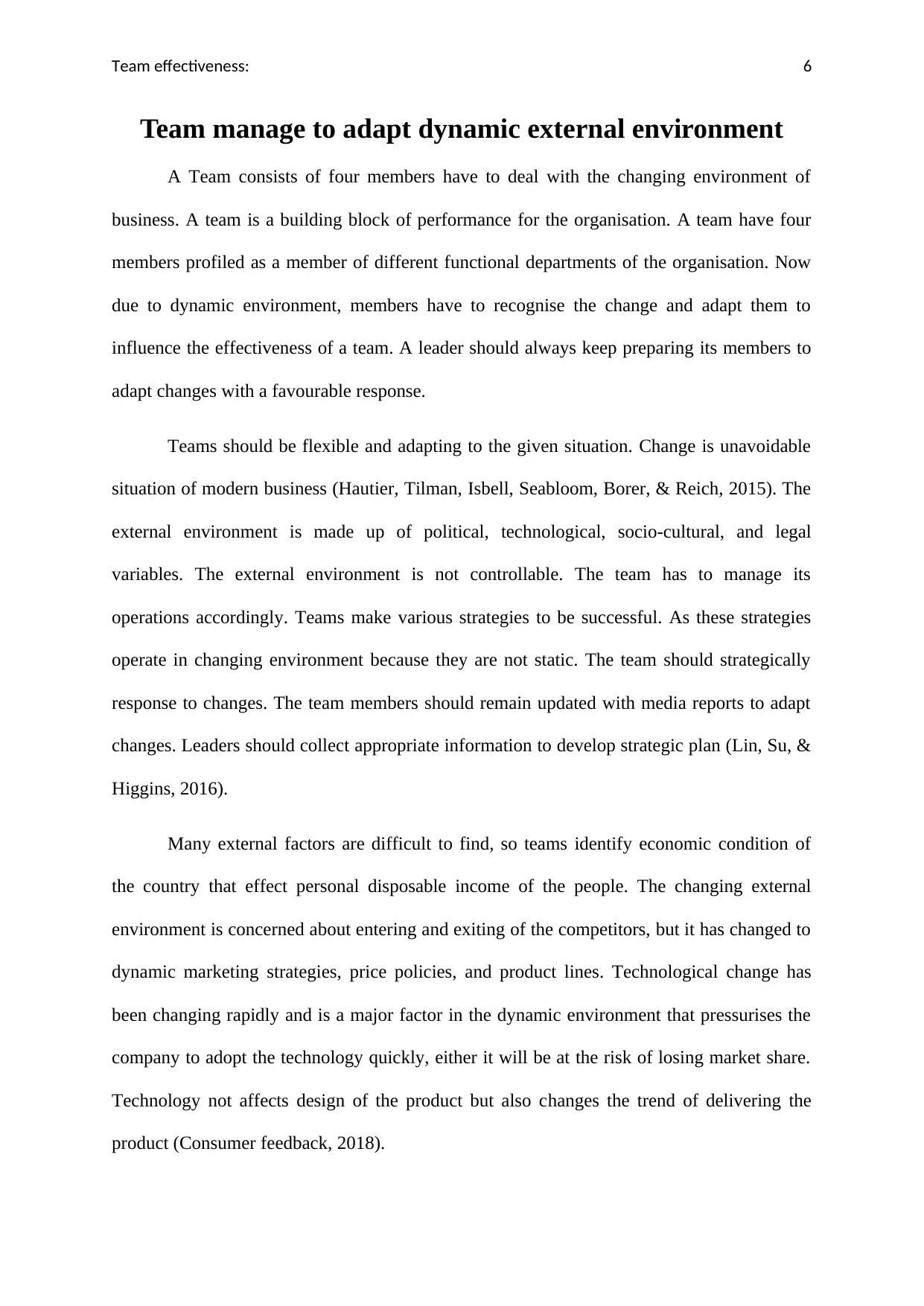
Team effectiveness: 6
Team manage to adapt dynamic external environment
A Team consists of four members have to deal with the changing environment of
business. A team is a building block of performance for the organisation. A team have four
members profiled as a member of different functional departments of the organisation. Now
due to dynamic environment, members have to recognise the change and adapt them to
influence the effectiveness of a team. A leader should always keep preparing its members to
adapt changes with a favourable response.
Teams should be flexible and adapting to the given situation. Change is unavoidable
situation of modern business (Hautier, Tilman, Isbell, Seabloom, Borer, & Reich, 2015). The
external environment is made up of political, technological, socio-cultural, and legal
variables. The external environment is not controllable. The team has to manage its
operations accordingly. Teams make various strategies to be successful. As these strategies
operate in changing environment because they are not static. The team should strategically
response to changes. The team members should remain updated with media reports to adapt
changes. Leaders should collect appropriate information to develop strategic plan (Lin, Su, &
Higgins, 2016).
Many external factors are difficult to find, so teams identify economic condition of
the country that effect personal disposable income of the people. The changing external
environment is concerned about entering and exiting of the competitors, but it has changed to
dynamic marketing strategies, price policies, and product lines. Technological change has
been changing rapidly and is a major factor in the dynamic environment that pressurises the
company to adopt the technology quickly, either it will be at the risk of losing market share.
Technology not affects design of the product but also changes the trend of delivering the
product (Consumer feedback, 2018).
Team manage to adapt dynamic external environment
A Team consists of four members have to deal with the changing environment of
business. A team is a building block of performance for the organisation. A team have four
members profiled as a member of different functional departments of the organisation. Now
due to dynamic environment, members have to recognise the change and adapt them to
influence the effectiveness of a team. A leader should always keep preparing its members to
adapt changes with a favourable response.
Teams should be flexible and adapting to the given situation. Change is unavoidable
situation of modern business (Hautier, Tilman, Isbell, Seabloom, Borer, & Reich, 2015). The
external environment is made up of political, technological, socio-cultural, and legal
variables. The external environment is not controllable. The team has to manage its
operations accordingly. Teams make various strategies to be successful. As these strategies
operate in changing environment because they are not static. The team should strategically
response to changes. The team members should remain updated with media reports to adapt
changes. Leaders should collect appropriate information to develop strategic plan (Lin, Su, &
Higgins, 2016).
Many external factors are difficult to find, so teams identify economic condition of
the country that effect personal disposable income of the people. The changing external
environment is concerned about entering and exiting of the competitors, but it has changed to
dynamic marketing strategies, price policies, and product lines. Technological change has
been changing rapidly and is a major factor in the dynamic environment that pressurises the
company to adopt the technology quickly, either it will be at the risk of losing market share.
Technology not affects design of the product but also changes the trend of delivering the
product (Consumer feedback, 2018).
Paraphrase This Document
Need a fresh take? Get an instant paraphrase of this document with our AI Paraphraser
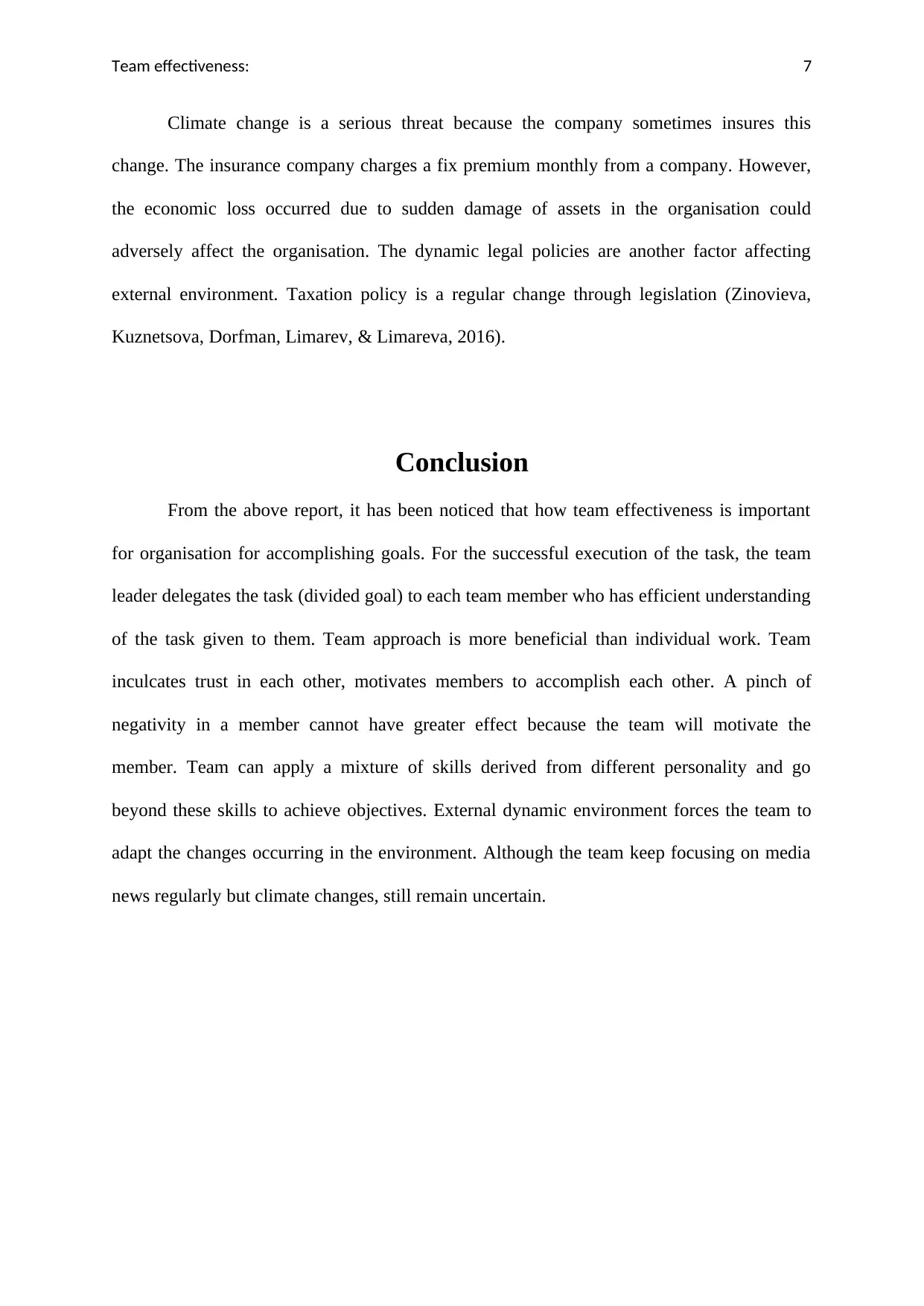
Team effectiveness: 7
Climate change is a serious threat because the company sometimes insures this
change. The insurance company charges a fix premium monthly from a company. However,
the economic loss occurred due to sudden damage of assets in the organisation could
adversely affect the organisation. The dynamic legal policies are another factor affecting
external environment. Taxation policy is a regular change through legislation (Zinovieva,
Kuznetsova, Dorfman, Limarev, & Limareva, 2016).
Conclusion
From the above report, it has been noticed that how team effectiveness is important
for organisation for accomplishing goals. For the successful execution of the task, the team
leader delegates the task (divided goal) to each team member who has efficient understanding
of the task given to them. Team approach is more beneficial than individual work. Team
inculcates trust in each other, motivates members to accomplish each other. A pinch of
negativity in a member cannot have greater effect because the team will motivate the
member. Team can apply a mixture of skills derived from different personality and go
beyond these skills to achieve objectives. External dynamic environment forces the team to
adapt the changes occurring in the environment. Although the team keep focusing on media
news regularly but climate changes, still remain uncertain.
Climate change is a serious threat because the company sometimes insures this
change. The insurance company charges a fix premium monthly from a company. However,
the economic loss occurred due to sudden damage of assets in the organisation could
adversely affect the organisation. The dynamic legal policies are another factor affecting
external environment. Taxation policy is a regular change through legislation (Zinovieva,
Kuznetsova, Dorfman, Limarev, & Limareva, 2016).
Conclusion
From the above report, it has been noticed that how team effectiveness is important
for organisation for accomplishing goals. For the successful execution of the task, the team
leader delegates the task (divided goal) to each team member who has efficient understanding
of the task given to them. Team approach is more beneficial than individual work. Team
inculcates trust in each other, motivates members to accomplish each other. A pinch of
negativity in a member cannot have greater effect because the team will motivate the
member. Team can apply a mixture of skills derived from different personality and go
beyond these skills to achieve objectives. External dynamic environment forces the team to
adapt the changes occurring in the environment. Although the team keep focusing on media
news regularly but climate changes, still remain uncertain.

Team effectiveness: 8
References
Consumer feedback, (2018). Strategic responses to changes in the external environment: a
case of east African breweries limited. Retrieved from:
http://business.uonbi.ac.ke/node/1588
Eisenstat, S. A., Chang, Y., Porneala, B. C., Geagan, E., Wilkins, G., Chase, B., & Finn, D.
(2017). Development and implementation of a collaborative team care model for
effective insulin use in an academic medical center primary care network. American
Journal of Medical Quality, 32(4), 397-405.
Hautier, Y., Tilman, D., Isbell, F., Seabloom, E. W., Borer, E. T., & Reich, P. B. (2015).
Anthropogenic environmental changes affect ecosystem stability via biodiversity.
Science, 348(6232), 336-340.
Helfat, C. E., & Martin, J. A. (2015). Dynamic managerial capabilities: Review and
assessment of managerial impact on strategic change. Journal of Management, 41(5),
1281-1312.
Ingram, D. (2018). Elements for effective teamwork. Retrieved from:
https://smallbusiness.chron.com/elements-effective-teamwork-964.html
Leoisaac, (2018). Environmental Factors in Strategic Planning. Retrieved from:
http://www.leoisaac.com/planning/strat016.htm
Levi, D. (2015). Group dynamics for teams. US: Sage Publications.
References
Consumer feedback, (2018). Strategic responses to changes in the external environment: a
case of east African breweries limited. Retrieved from:
http://business.uonbi.ac.ke/node/1588
Eisenstat, S. A., Chang, Y., Porneala, B. C., Geagan, E., Wilkins, G., Chase, B., & Finn, D.
(2017). Development and implementation of a collaborative team care model for
effective insulin use in an academic medical center primary care network. American
Journal of Medical Quality, 32(4), 397-405.
Hautier, Y., Tilman, D., Isbell, F., Seabloom, E. W., Borer, E. T., & Reich, P. B. (2015).
Anthropogenic environmental changes affect ecosystem stability via biodiversity.
Science, 348(6232), 336-340.
Helfat, C. E., & Martin, J. A. (2015). Dynamic managerial capabilities: Review and
assessment of managerial impact on strategic change. Journal of Management, 41(5),
1281-1312.
Ingram, D. (2018). Elements for effective teamwork. Retrieved from:
https://smallbusiness.chron.com/elements-effective-teamwork-964.html
Leoisaac, (2018). Environmental Factors in Strategic Planning. Retrieved from:
http://www.leoisaac.com/planning/strat016.htm
Levi, D. (2015). Group dynamics for teams. US: Sage Publications.
⊘ This is a preview!⊘
Do you want full access?
Subscribe today to unlock all pages.

Trusted by 1+ million students worldwide

Team effectiveness: 9
Lin, H. F., Su, J. Q., & Higgins, A. (2016). How dynamic capabilities affect adoption of
management innovations. Journal of Business Research, 69(2), 862-876.
McQuerrey, L. (2018). The importance of trust within a team. Retrieved from:
https://work.chron.com/importance-trust-within-team-3940.html
Shuffler, M. L., Diazgranados, D., Maynard, M. T., & Salas, E. (2018). Developing,
Sustaining, and Maximizing Team Effectiveness: An Integrative, Dynamic
Perspective of Team Development Interventions. Academy of Management
Annals, 12(2), 688-724.
Woodcock, M. (2017). Team development manual. UK: Routledge.
Zinovieva, C. G., Kuznetsova, M. V., Dorfman, T. V., Limarev, P. V., & Limareva, J. A.
(2016). Study of external and internal factors affecting enterprise’s stability.
Advances in Systems Science and Applications, 16(1), 62-71.
Lin, H. F., Su, J. Q., & Higgins, A. (2016). How dynamic capabilities affect adoption of
management innovations. Journal of Business Research, 69(2), 862-876.
McQuerrey, L. (2018). The importance of trust within a team. Retrieved from:
https://work.chron.com/importance-trust-within-team-3940.html
Shuffler, M. L., Diazgranados, D., Maynard, M. T., & Salas, E. (2018). Developing,
Sustaining, and Maximizing Team Effectiveness: An Integrative, Dynamic
Perspective of Team Development Interventions. Academy of Management
Annals, 12(2), 688-724.
Woodcock, M. (2017). Team development manual. UK: Routledge.
Zinovieva, C. G., Kuznetsova, M. V., Dorfman, T. V., Limarev, P. V., & Limareva, J. A.
(2016). Study of external and internal factors affecting enterprise’s stability.
Advances in Systems Science and Applications, 16(1), 62-71.
1 out of 10
Related Documents
Your All-in-One AI-Powered Toolkit for Academic Success.
+13062052269
info@desklib.com
Available 24*7 on WhatsApp / Email
![[object Object]](/_next/static/media/star-bottom.7253800d.svg)
Unlock your academic potential
Copyright © 2020–2025 A2Z Services. All Rights Reserved. Developed and managed by ZUCOL.





